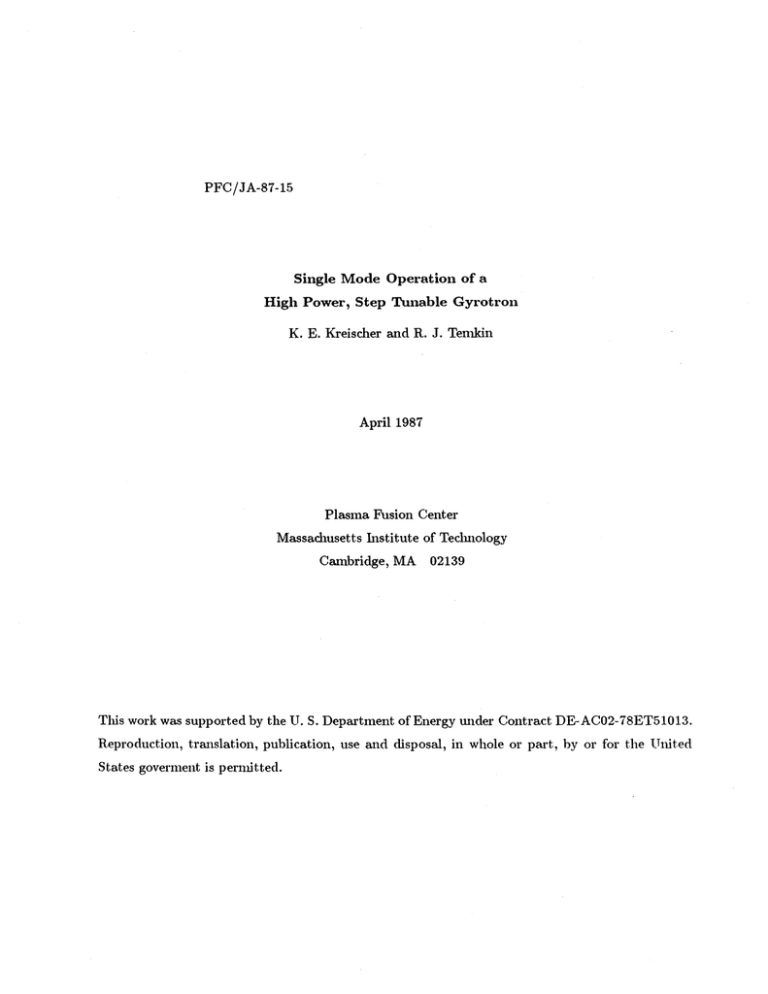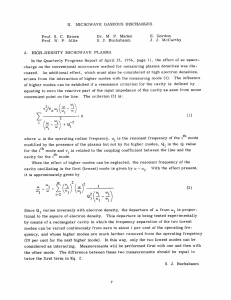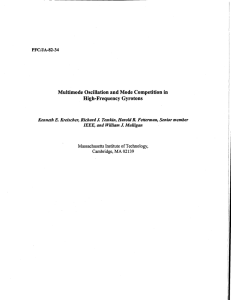PFC/JA-87-15
advertisement

PFC/JA-87-15 Single Mode Operation of a High Power, Step Tunable Gyrotron K. E. Kreischer and R. J. Temkin April 1987 Plasma Fusion Center Massadiusetts Institute of Tecimology Cambridge, MA 02139 This work was supported by the U. S. Department of Energy under Contract DE-AC02-78ET51013. Reproduction, translation, publication, use and disposal, in whole or part, by or for the United States goverment is permitted. Single Mode Operation of a High Power, Step Tunable Gyrotron K.E. Kreischer and R.J. Temkin Plasma Fusion Center Massachusetts Institute of Technology Cambridge, Massachusetts 02139 A gyrotron oscillator with a single cylindrical cavity has produced output powers up to 645 kW and efficiencies up to 24% at 140.8 GHz, and step tunable single mode operation between 126 and 243 GHz. Mode stability and suppression of nearby competing modes are found to persist even when operating in very high order cavity modes with severe mode competition. These results greatly improve prospects of developing cw megawatt gyrotrons relevant to the heating of fusion plasmas. 1 In recent years, intensive research has been conducted on novel sources of high power radiation at millimeter wavelengths. Important advances have been reported in research on electron cyclotron masers such as the gyrotron,' and other novel devices.' 4 Cerenkov sources,' free electron lasers," For application to plasma heating at millimeter wavelengths, which requires CW or long pulse operation, the gyrotron has achieved the most impressive results, with 100 kW, CW operation at 140 GHz 4 and 200 kW, CW at 60 GHz.10 The extension of gyrotron operation to high frequencies, at least 250 GHz, and megawatt power levels will be required for future applications in ECR heating, such as for the proposed compact ignition tokamak (CIT), a 10 T device, or for a fusion reactor. One major obstacle to increasing the power and frequency of gyrotrons is the need to operate in high order modes." An important physics issue is the stability of operation of an oscillator in a highly overmoded cavity with minimal mode separation and severe mode competition. Although stable, single mode operation may be possible under such conditions due to mode suppression,14 previous experimental evidence for this has been lacking in highly overnioded gyrotrons. This paper reports a major advance in gyrotron research with the achievement of power levels of over 0.5 MW at frequencies up to 243 GHz in short pulse operation. These results were obtained with a gyromonotron utilizing a single, tapered cavity. Only one previous gyrotron device (of moderate voltage) has achieved such high power levels, a Soviet 2.1 MW, 100 GHz gyrotron3 ; however, no details have been reported of the nature of that device or its operating mode. The present results, although obtained in short pulse operation, indicate that the gyrotron is very promising for further development as a CW, megawatt power level source for application to plasma heating in future plasma machines. The tapered cavity has been previously questioned with regard to its ability to maintain single mode operation at high power and frequency. As a result, a number of innovative approaches to mode control have been suggested, such as the complex cavity (or step cavity), 2 which has proven successful at lower frequencies, and quasioptical cavities, particularly Fabry-Perot cavities.' 2 Our experiments indicate that the tapered cavity is, in 2 fact, remarkably effective in providing efficient, single mode emission even when the cavity is highly overmoded. Single mode operation has been achieved in the TE 22,4 mode, the 377th transverse mode of a circular waveguide, corresponding to a cavity diameter of 12A (A is the free space radiation wavelength). This cavity is also easily fabricated, and can be step tuned by varying the applied cavity magnetic field. Such step tuning may be useful during plasma heating when the magnetic field applied to the plasma is varied, or for reasons of controlling the plasma. The mode of a weakly tapered gyrotron cavity can be approximated as a TEpq mode of a circular cylinder cavity, where m, p, q are the azimuthal, radial and longitudinal mode indices, respectively. The oscillation frequency w is given by W2/C2 = k2 = k + k (1) where k1 = v,/R 0 and kl = qir/L, R and L are the cavity radius and length, and v,,, is the pth root of J,(x) = 0. The condition for excitation of the cyclotron instability is w - k11/311c = nwc = nwco/ where wc = eB 0 /m is the cyclotron frequency, velocity normalized by c. = (1 - 02), and 3 is the total beam The velocity components parallel and perpendicular to the magnetic field B0 are given by #11and will be considered in this paper. W ~ v 1,c/R, y-2 (2) 3 1j respectively. Only fundamental operation (n=1) For a gyrotron operating near cutoff, kj_ > ki and ~ w,. For a given -y and R,, a mode represented by vmp and oscillating at w is only excited over a narrow range in B,. By varying the magnetic field, a sequence of discrete modes can be excited. The excitation region for each mode can be determined by combining the linearized equations of motion13 with the equilibrium condition within the cavity. This results in the following threshold condition for the beam current: Ith(A) = 2190 11 Asexp(2x QT L px - 1 3 1 mP (3) where SSM =~(vi, j 2r2,±i(kLRe) - m 2 )J2(mp) y =lr(/1//01i)(L/A) and x = L(o - wc)/4cI311. The total cavity Q, QT, includes diffractive and ohmic losses. A Gaussian axial field profile has been assumed. The choice of sign depends on the azimuthal rotation of the rf field. Figure 1 shows Ith for modes in our cavity between 135 and 144 GHz, indicating the high density of modes present. In our tapered resonator, single mode operation is the result of three factors: beam quality, cavity attributes that reduce the number of competing modes, and mode suppression. Beam quality is important because a spreadin 7, #,3 or 011 can cause some electrons to become resonant with competing modes' 4 as well as reduce the efficiency. The density of competing modes has been reduced by designing the resonator tapers to produce strong diffractive losses at the cavity ends for q > 2 modes, allowing the q = 1 to dominate. Further mode selection was achieved by choosing the electron beam radius that results in preferential coupling to the desired transverse TEmp mode structure. As a result, the number of competing modes in our cavity scales approximately as A rather than V\. 4 18 9 Mode suppression in tapered cavities has been extensively modeled in the past. ' " These simulations indicate that once a mode becomes established within a cavity, the nonlinear pertubation of the beam increases the threshold conditions for other modes, especially when the established mode interacts efficiently with the beam. Therefore, the desired mode must be excited before unwanted modes are excited as the gun voltage is raised to its steady state value." Although nearby modes can be excited by the sideband 1 1 7 generation mechanism, which is called nonlinear parasitic mode excitation in gyrotrons, 6' 7 this effect has been previously shown to be relatively weak in gyrotron oscillators.' A nu- merical simulation of our experiment would be of great interest but is beyond the scope of this paper. However, our experimental results agree qualitatively with previous simulations. In fact, the degree of success of mode locking in the present experiments is remarkable and can probably be even more effective in CW operation. The design of the present experiment consisted of first identifying specific modes, such 4 as TE 5 ,2 ,1, which have a relatively wide separation from nearby modes. The cavity and high quality electron beam were then designed to excite the desired mode first, as the voltage was raised, while avoiding parasitic modes and sideband generated modes. Supression of nearby modes in saturated operation then assured single mode operation. The cavity was also designed to overcome certain technological constraints. For example, an ohmic wall loss of less than 2kW/cm 2 was maintained so that future development (by industry) to the CW regime for plasma heating is feasible. A schematic of our experiment is shown in Fig.2. The gyrotron operates at 4 Hz with 3 psec pulses. The magnetron injection gun, which was built by Varian, produces a beam with a theoretical I3/oi= 1.93 and a spread in #8 of 4% at 80 kV and 35 A. 2 ' The beam has been placed relatively close to the wall to minimize voltage depression by the space charge field. The cavity magnetic field is provided by a Bitter copper magnet capable of fields up to 9.7 T. There is also a small gun coil centered at the cathode for optimizing the beam quality. The cavity, which consists of a straight cylindrical section terminated at each end by linear tapers, has an effective L of 6A, and a diffractive Q of 415. The radiation produced is transmitted via a 2.54 cm ID copper waveguide to a broadband motheye window, 20 and broadcast into a shielded box where measurements of the power, frequency, and far field pattern can be made.1 In the first set of experiments, stable operation was achieved in the TEi5 ,2 ,1 mode at 140.8 GHz. Output powers up to 645 kW were measured at 80 kV and 35 A with single mode emission. The efficiency peaked at 24% at 15 A, and remained between 20 and 24% at higher currents. This contrasts with self-consistent nonlinear theory, which suggests that the efficiency should continue to increase to 38% at 35 A. The observed degradation of efficiency at higher currents may be due to several effects, including mode competition from the TE 1 ,3,1 mode, which was observed at 136.4 GHz. The highest TE 5 ,2 ,1 powers occur along the boundary with the TE 1 ,3,, oscillation region. The optimum cavity magnetic field of 5.48 T at 35 A agrees with predictions based on nonlinear theory. It was found that the gyrotron was sensitive to the magnetic field settings. Minimal second harmonic (n=2) 5 emission was observed, probably due to suppression by the dense fundamental spectrum. The tuning of our gyrotron was investigated as the magnetic field was varied from 4.8 T to 9.7 T. The results are shown in Fig.3. The dominant modes observed corresponded to the p=2, 3, and 4 radial modes. For each series, high power single mode emission was detected at discrete frequencies separated by about 7 GHz corresponding to a sequence of azimuthal (m) modes with q=1. In the highest order mode observed (TE 2 2 ,4 ,1 with D=12.2A), 470 kW was generated at 243 GHz in a single mode. This data indicates that the gun, although designed for operation at 140 GHz, produces a high quality beam over the entire range from 126 to 243 GHz. It also appears that high powers could be achieved at even higher frequencies if magnetic fields above 9.7 T were available. The normalized current' 3 I is also plotted in Fig. 3 for the observed modes using the actual beam radius and including the effect of higher magnetic compression at higher frequencies. This parameter is defined as: I 0.59 X 10~4_ -y)31 A Sm L (4) In Fig.3, only the maximum value of Smp for the two rotating modes is plotted. This graph indicates that the output power scales approximately as I, as would be expected from nonlinear theory. 3 The curves for I also predict a transition from the p=2 to the p= 3 modes at about 165 GHz, and from the p=3 to the p= 4 modes at about 225 GHz, in agreement with our observations. The step tunable behavior of the gyromonotron can be understood by analyzing the coupling strength S, between the beam and rf field. A plot of S, is shown in Fig. 4 for the TEi5 ,2 ,1 mode and neighboring parasitic modes. The beam is located between Re/Ro of 0.69 and 0.72, ensuring good coupling to the TEi5 ,2,1 and suppression of the competing modes. A plot of Sp for other nearby TE, 2 ,1 modes would show a similar functional dependence. For example, the inner maximum occurs at Re/Ro=0.70 for the TE13 ,2 ,1 and at 0.75 for the TEi8 ,2 ,1 mode. Thus, choosing Re for strong coupling to the TEi5 ,2 ,1 mode automatically leads to strong coupling to nearby TEm, 2,1 modes, resulting in strong emission from these modes. 6 In summary, single mode, step-tunable operation of a gyromonotron with powers up to 645 kW has been demonstrated between 126 and 245 GHz. These results make the cylindrical cavity highly competitive with alternative approaches, such as the complex cavity and quasioptical gyrotron. Additional mode suppression techniques, such as the coaxial insert,2 2 could make the gyromonotron even more attractive. These results suggest that megawatt gyrotron sources at frequencies relevant to the heating of fusion plasmas should be feasible. This work was supported by the Department of Energy. The Bitter magnet was provided by the National Magnet Laboratory. The authors wish to thank Dr. A. Singh, Mr. W.J. Mulligan, Ms. S.E. Spira, Dr. B.G. Danly, and Dr. C.Y. Wang for their assistance. We also thank Dr. H. Jory, Dr. K. Felch, and Dr. H. Huey for helpful discussions, and their contributions to the development of the high quality electron gun. 7 References 'K. E. Kreischer et al., Int. J. Elec. 57, 835 (1984). 2 Y. Carmel et al., Phys. Rev. Lett. 50, 112 (1983). 3 A. SH. Fix et al., Int. J. Elec. 57, 821 (1984). 4K. Felch et al., Int. J. Elec. 61, 701 (1986). 'J. Walsh, B. Johnson, G. Dattoli, and A. Renieri, Phys. Rev. Lett. 53, 779 (1984). 'T. J. Orzechowski et al., Phys. Rev. Lett. 57, 2172 (1986). 7 J. Fajans, G. Bekefi, Y.Z. Lin, and B. Lax, Phys. Rev. Lett. 53, 246 (1984). 'S. H. Gold, D. L. Hardesty, and A. K. Kinkead, Phys. Rev. Lett. 52, 1218 (1984). 'H. A. Davis et al., Phys. Rev. Lett. 55, 2293 (1985). 0" K. Felch et al., In Proc. Fourth Int. Symp. on Heating in Toroidal Plasmas, Rome, Italy, 1165 (1984). "K. E. Kreischer, B. G. Danly, J. B. Schutkeker, and R. J. Temkin, IEEE Trans. Plasma Science 13, 364 (1985). ' 2 T. Hargreaves, K. Kim, J. McAdoo, S. Park R. Seeley, and M. Read, Int. J. Elec. 57, 977 (1984). 3 B. G. Danly and R. J. Temkin, Phys. Fluids 29, 561 (1986). "I. G. Zarnitsina and G. S. Nusinovich, Radiophys. Quantum Elect. 17, 1418 (1974). ' 5 K. E. Kreischer and R. J. Temkin, Int. J. Infrared and Millimeter Waves 2, 175 (1981). "6 K. E. Kreischer et al., IEEE-MTT 32, 481 (1984). 8 "G. S. Nusinovich, Int. J. Elec. 51, 457 (1981). '8 D. Dialetis and K.R. Chu, Infrared and Millimeter Waves, Ed. By K.J. Button, Vol. 7, Chapter 10, Academic Press (1983). "V. L. Vomvoridis, Int. J. Infrared and Millimeter Waves 3, 339 (1982). 2 0J.Y.L. Ma and L.C. Robinson, Optica Acta 30, 1685 (1983). "H. Huey et al., Tenth Int. Conf. Infrared and Millimeter Waves Digest, IEEE Catalog No. 85CH2204-6, 223 (1985). 2 1 K. E. Kreischer, A. Singh, S. E. Spira, and R. J. Temkin, IEDM Technical Digest, IEEE Catalog No. 86CH 2381-2, 330 (1986). 9 FIGURE CAPTIONS Figure 1 Threshold current Ith(A) for the TE1 5 ,2 ,1 and nearby modes. Figure 2 Schematic of the gyrotron Figure 3 Solid lines- Measured output power for TEm,,,1 modes at 80 kV and 35 A. Dashed lines-The theoretical normalized current I for these modes. Figure 4 Coupling strength Smp (see Eq.(3)) versus the normalized beam radius. The beam is centered at 0.71. 10 (D (D Lf I -- UU) U LQ o L-) 00 rf) 0 0 N~ (V) LN3U8flD CIOHS38HI o w I 0: 0 z () 0 00 m <00 -0 0 0 U iiJ 10 0 I- Li ( Li 0I C I F. I. C L-ILii z - _ _ -LJ 0 w 0 0 M L) -J 0 0 z z 0-L NORMALIZED CURRENT x 102 0 0 0 c'j I U.) N~ 0 I i 0 11. EE - -r 0 0 / N N1 0 "/ / N z E Ld / LU 0 U.0 u- 00 0.) II E I (D 0 6 I 0. I I r') I N~ ci 0i di (MV4J) 8I3MOd ifldifo 0 I 6 J0 C -'I I N OD w dopp uJ 0 uJ dF. N L6. (D- 0 z I C d N 201 X Hi!N3diS ONI-ldOD bO






